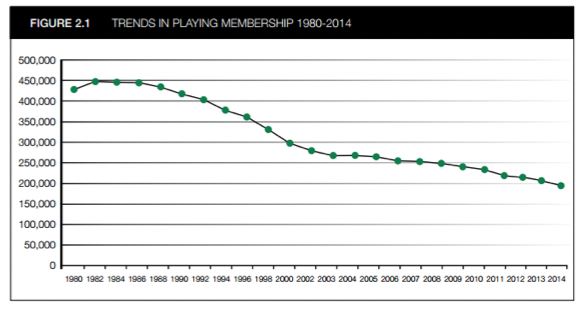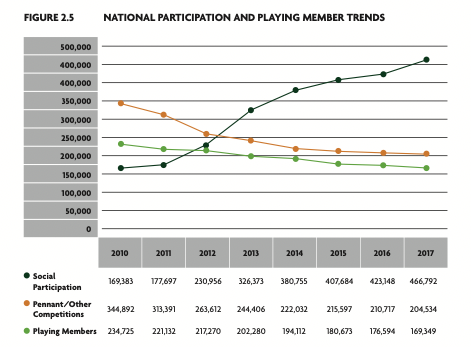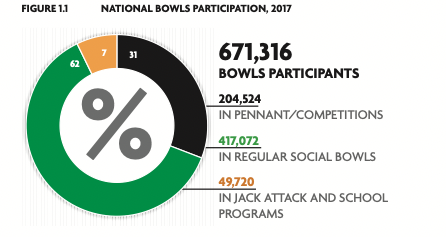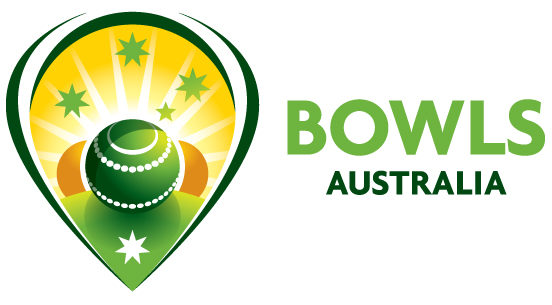Membership Capitation and the Fixed Fee Model
Bowls Australia CEO Neil Dalrymple has taken the time to address one of the most important issues currently concerning the sport of bowls, the membership fee structure, and the benefits of a fixed fee model.
For those who want to get directly to the heart of the matter, there is a Frequently Asked Questions section at the end of this article that addresses some common queries pertaining to membership capitation.
Preamble
The fixed fee model was introduced by Bowls Australia (BA) in 2016/17 and is designed to provide an incentive to disclose members and participants and for these details to be included into the Bowls Connect database, therefore providing a better indication of membership and participation figures. It is also designed to encourage clubs to be more flexible with the categories of membership offered and to facilitate a more progressive revenue flow from membership
There is still a lot of debate and a lack of understanding about this issue but clearly, despite much-written information being circulated, a face-to-face explanation to clubs, associations, districts and zones is the most effective means of communicating this information and the changes it has on the sport as a whole, as well as on each organisation individually.
It is often an emotional conversation and it is important that any change is explained clearly, especially when it relates to money and what is being paid to the peak bodies for Bowls at State and National level.
In this document, I wish to explain some of the changes to membership occurring in some states and territories and the background surrounding these changes.
Membership and Participation trends
It is important to firstly explain that the basis for change to the membership structure is due to a number of factors and trends but most importantly, it is in response to a 25 year-on-year decline in formal membership across the sport in Australia, as can be seen in table 1 below.
Table 1: This graph articulates the extent of this decline, showing a total national membership of 450,000 in 1982 and its continual decline to around 180,000 in 2016.
This graph articulates the extent of this decline, showing a total national membership of 450,000 in 1982 and its continual decline to around 180,000 in 2016.
Conversely, over the last five years, regular social participation in Bowls in Australia has increased year-on-year, at an average annual rate of 3.92% as outlined in the 2016 National Bowls Census Report.
This trend is supported by research conducted by Bowls Australia in 2011 commissioned in conjunction with La Trobe University and the ‘Megatrends’ research conducted by the Australian Sports Commission in 2014.
Both research reports identified that social participation in sport is expected to grow at the expense of formal and traditional membership offerings. This is consistent with the reality at club level, with many clubs now relying more and more on participation programs and social bowls for their revenue.
The main reasons for this trend centred around a changing attitude of society, with individuals becoming increasingly reluctant to commit to the traditional club structure of Australian sport, competing entertainment interests, greater demands in the workforce and a general trend of wanting to participate in their sport that was more flexible in timings and offerings.
This is demonstrated in Table 2 (below), which demonstrates the growth in social participation at the expense of traditional formats, and table 3, which identifies the overall increase in total participation.
Table 2: 
Table 3:
Total Participation 2017

Formal membership in Bowls in Australia has continued to decline in 2016, but some solace can be taken from the fact that it was only by 2%. Total participation in Bowls in Australia continues to increase at an average rate of 3.92 % per annum, due to the growth of social participation as emphasised in the charts above.
What’s wrong with the current (per-member) membership model?
The current model of charging STAs on a per member basis is unsustainable, due to the changing participation preferences of bowlers moving away from traditional membership. A sport that has recently faced similar challenges to bowls is tennis, which has also changed their membership model for the same reasons.
To provide background to the issue, Bowls clubs across Australia have been increasingly setting up social membership categories as a response to continual fee increases to individual membership fees, to avoid paying full individual capitation fees to their STA and BA, but are wrongly giving playing rights to these bowlers.
This trend has caused the STAs and BA to respond to the declining membership base by increasing their membership fees to maintain their revenue base. In practice, a per-member capitation fee has previously lead to an increased per member cost to clubs and therefore clubs under-reporting or introducing non-capitated membership categories to avoid increasing their per-member cost.
This is clearly not a sustainable model and BA believes clubs should be encouraged, not hindered, to diversify their membership categories to maximise their membership.
The financial model for Bowls in Australia still relies on revenue being generated from the grass-roots of the sport (i.e. membership). BA’s revenue from membership is approximately 35% of total revenue, whilst most STAs are well over 50%. One of the great opportunities for the sport is to become less reliant on membership revenue is by generating other sources of revenue, which can be achieved through a more robust and accurate database of members and participants.
For these reasons, introducing a new membership model and moving away from a per-member capitation model is the path that BA is now promoting with the STAs.
The aims and benefits of a new fixed fee membership model
The new membership fixed fee model was introduced by BA for the STAs in the 2016/17 financial year. Each STA will pay a fixed fee based on what they paid BA in 2015/16, plus an additional 3% to account for CPI. Future % changes will be determined by the BA Board in their budgeting process.
BA is actively encouraging the STAs to adopt a similar model with their constituent members. The aim of the new model is to gain a truer understanding of the members and participants playing in the sport, while at the same time allowing clubs to become more flexible with their membership offerings.
As a result of having a true record of participants, BA and STAs will be able to:
• Highlight the reach of the sport of bowls with Governments and funding bodies as a means to generate greater levels of investment;
• Promote bowls as a more attractive sponsorship prospect;
• Improve the understanding of the demographics and geographical spread of members/participants to improve planning for facilities, events and member services;
• Limit membership fee increases on a per capita basis;
• Enable organisations to plan more effectively by providing a fixed membership fee for which to budget for.
The new model is designed to provide an incentive for clubs to disclose all members and participants and for these details to be included into the National Bowls Connect database, therefore providing a better record of membership and participation figures.
It is envisaged that, by knowing exactly what the membership fee is for any given year, clubs will be able to design a membership portfolio that suits them and which enables them to offset their fixed membership fee and potentially grow their revenue through membership.
By adopting this process, it is envisaged that the number of actual participants in our sport will continue to increase as a result of this amended membership fee structure.
Summary and concluding remarks
In summary, it is important to highlight that it is at the discretion of each STA to determine the membership fees charged to their members, who in most cases are the Clubs. However, BA strongly recommends that the best membership option for each is a fixed fee model.
A number of STAs are already moving to a club-based fixed fee model rather than a per-member fee. Bowls Victoria implemented this type of model in 2014/15 and Bowls WA and NSW (men) have introduced a similar one for 2016/17, and Bowls SA in 2017/18.
The fixed fee membership model enables more flexibility for clubs to set their own membership categories and an applicable membership fee amount and provides clubs with certainty around how much they have to budget for yearly membership fee payments to their STA.
Bowls clubs need to consider, where possible, how they can utilise their club’s assets to generate other sources of income and not rely on the traditional membership sources, as has been the case for many years.
Flexible participation/membership options, corporate and social bowls formats, and the adoption of national programs such as Jack Attack and Jr. Jack Attack all provide new revenue opportunities for the sport and its clubs into the future.
The sport of Bowls in Australia is at an interesting juncture in its history and it is important that administrators at all levels embrace the challenges and opportunities that exist so that we can secure a strong and prosperous future for our great sport.
In order to shed more light on the topic of membership capitation, BA has prepared answers to the following Frequently Asked Questions.
FAQ:
1) Why has BA moved to a new membership capitation system?
The ‘old’ system negatively impacts on clubs who are gaining members, we’d like to move to a system that rewards good performance.
2) Have any STAs moved to the new system?
Yes, Bowls Victoria, Bowls WA, Bowls NSW (men) and Bowls SA.
3) Are clubs being advantaged or disadvantaged by the fixed fee model?
Advantaged, the more members a club has, the cheaper the affiliation fees are.
4) Have any other sports moved to this system?
Yes, Tennis transitioned successfully to this system in 2013.
5) What fees do bowlers pay and who does it go to?
Each bowler pays a fee to their club for membership. Of that fee, on average $48 goes to the applicable state/territory association. Of that $48, $11 goes to Bowls Australia. Of that $11, approximately $0.50 goes to World Bowls.
6) Is membership really an issue?
Yes, clubs with a strong membership base will be stronger clubs. But clearly, it isn’t the only issue.
7) Why are there such healthy participation numbers yet such poor membership numbers?
Participation isn’t linked to a fee payable to the state/territory association and therefore is a far more accurate number, demonstrating the sport of bowls is alive and healthy.
8) What does this mean for membership classes that clubs can offer?
Ultimate flexibility. Any club is free to offer any membership class that suits their needs.
9) Who is the real winner out of this new system?
Just about everyone. Clubs, state/territory associations and the sport in general.
If you require any further information about what has been outlined in this document, please contact me at ndalrymple@bowls.com

